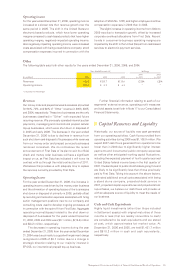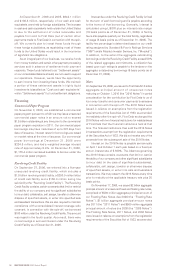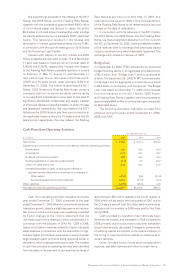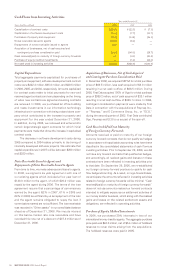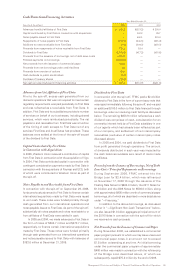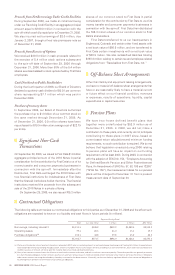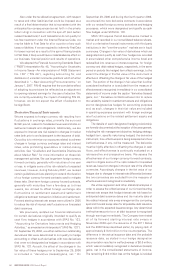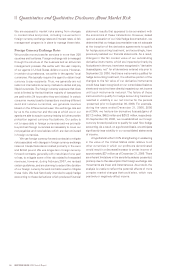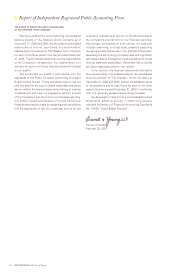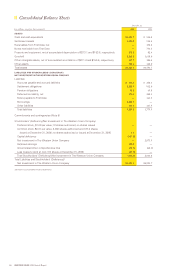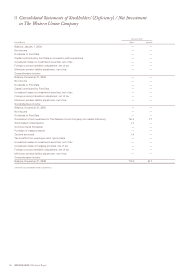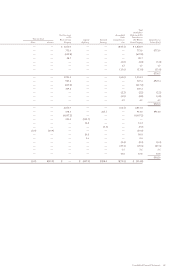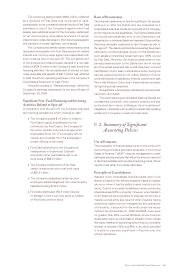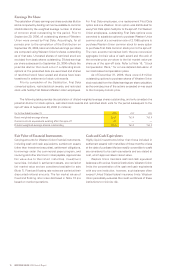Western Union 2006 Annual Report Download - page 62
Download and view the complete annual report
Please find page 62 of the 2006 Western Union annual report below. You can navigate through the pages in the report by either clicking on the pages listed below, or by using the keyword search tool below to find specific information within the annual report.WESTERN UNION 2006 Annual Report 60
We are exposed to market risks arising from changes
in market rates and prices, including movements in
foreign currency exchange rates and interest rates. A risk
management program is in place to manage these risks.
Foreign Currency Exchange Rates
We provide money transfer services in more than 200
countries and territories. Foreign exchange risk is managed
through the structure of the business and an active risk
management process. We settle with the vast majority
of our agents in United States dollars or euros. However,
in certain circumstances, we settle in the agents’ local
currencies. We typically require the agent to obtain local
currency to pay recipients. Thus, we generally are not
reliant on international currency markets to obtain and pay
illiquid currencies. The foreign currency exposure that does
exist is limited by the fact that the majority of transactions
are paid within 24 hours after they are initiated. In certain
consumer money transfer transactions involving different
send and receive currencies, we generate revenue
based on the difference between the exchange rate set
by us to the consumer and the rate at which we or our
agents are able to acquire currency helping to further provide
protection against currency fluctuations. Our policy is
not to speculate in foreign currencies and we promptly
buy and sell foreign currencies as necessary to cover our
net payables and receivables which are denominated
in foreign currencies.
We use foreign currency forward contracts to mitigate
risks associated with changes in foreign currency exchange
rates on transactions denominated primarily in the euro
and British pound. We use longer-term foreign currency
forward contracts, generally with maturities of one year
or less, to mitigate some of the risk related to forecasted
revenues, however, during February 2007, we revised
certain guidelines, and are planning to extend the duration
of our foreign currency forward contracts used to mitigate
these risks. We had historically intended to apply hedge
accounting to these derivatives which produced financial
statement results that appeared to be consistent with
the economics of these transactions. However, based
upon an evaluation of our initial hedge documentation, we
determined that our hedge documentation was not adequate
at the inception of the derivative agreements to qualify
for hedge accounting treatment, and accordingly, have
previously restated our financial statements. As a result,
changes in the fair market value of our outstanding
derivative instruments, which are impacted primarily by
fluctuations in the euro, have been recognized in “derivative
(losses)/gains, net” for all derivatives entered into prior to
September 29, 2006. Had these instruments qualified for
hedge accounting treatment, the effective portion of the
changes to the fair value of our derivative instruments
would have been recognized on our consolidated balance
sheets and would not have directly impacted our net income
until such instruments matured. The failure of these
instruments to qualify for hedge accounting treatment
resulted in volatility in our net income for the periods
presented prior to September 30, 2006. For example,
during the years ended December 31, 2006, 2005
and 2004, we had pre-tax derivative (losses)/gains of
$(21.2) million, $45.8 million and $(30.2) million, respectively.
On September 29, 2006, we re-established our foreign
currency forward positions to qualify for cash flow hedge
accounting. As a result, on a go-forward basis, we anticipate
significantly less volatility in our consolidated statements
of income.
A hypothetical uniform 10% strengthening or weakening
in the value of the United States dollar relative to all
other currencies in which our profits are denominated
would result in a decrease/increase to pretax income of
approximately $27 million as of December 31, 2006. There
are inherent limitations in the sensitivity analysis presented,
primarily due to the assumption that foreign exchange rate
movements are linear and instantaneous. As a result, the
analysis is unable to reflect the potential effects of more
complex market changes that could arise, which may
positively or negatively affect income.
|| Quantitative and Qualitative Disclosures About Market Risk



